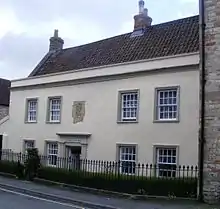St John's Priory, Wells
St John's Priory in Wells, Somerset, England, from the 14th century. Along with its boundary walls and railings it has been designated as a Grade I listed building.[1][2]
| St John's Priory | |
|---|---|
 | |
| Location | Wells, Somerset, England |
| Coordinates | 51°12′21″N 2°38′52″W |
| Built | Late 14th century |
Listed Building – Grade I | |
| Official name | St John's Priory |
| Designated | 12 November 1953[1] |
| Reference no. | 483533 |
 Location of St John's Priory in Somerset | |
The initial development was as a hospital for poor, aged and sick men by 1210.[3] The original foundation was by Jocelin of Wells, after his consecration in 1204, along with his brother Hugh of Wells.[4]
It was made into a priory in 1350 providing accommodation for a prior, chaplain and ten brothers, which lasted until the dissolution of the monasteries when it had an income of £40 per year.[5][6] It then became crown property until 1575 when it was given to Sir Christopher Hatton and later became the property of Baron Brooke.[7]
Land was donated to St John's in both 1667 and 1716.[8]
The former priory building may also have been used as a guest house for visitors to Wells Cathedral and the Bishop's Palace.[9] There was a cemetery associated with the building.[10] The history of the buildings is set out in 33 deeds including one from 1738 which is displayed in the dining room.[9]
The land surrounding the priory was disturbed and remaining archaeological remains destroyed around 1850 when new roads and a school were built on the site.[3] This also involved demolition of some of the building.[6] In the 1860s the building was owned by the Lovell family.[11]
The two-storey stone building was an open hall but a first floor corridor and bedrooms have been added. The roof is supported by cruck trusses and purlins. Dendochronology has shown the wood used for the roof was felled in the winter of 1313 to 1314.[9]
References
- "No.2 St John's Priory, with front boundary wall and railings, Wells". historicengland.org.uk. English Heritage. Retrieved 2009-01-13.
- "No.2 St John's Priory, with front boundary wall and railings". National Heritage List for England. Historic England. Retrieved 31 August 2016.
- Leach, Peter. "Becket Place, Wells An Archaeological Evaluation" (PDF). Archaeology Data Service. Peter Leach. Retrieved 31 August 2016.
- Serel, Thomas (1875). Historical notes on the church of saint Thomas in Wells, the priory of st. John [&c.]. pp. 7–8.
St John's Priory, Wells.
- "St John's Priory, Wells". Somerset Historic Environment Record. Somerset County Council. Retrieved 31 August 2016.
- Parker, J.H.; Parker, J. (1859). The Gentleman's Magazine and Historical Review, Volume 207. pp. 383–384.
- May, F. (1860). Proceedings, Volume 9. Somersetshire Archaeological and Natural History Society. pp. 12–18.
- Serel, Thomas (1875). Historical notes on the church of saint Thomas in Wells, the priory of st. John [&c.]. pp. 126–127.
St John's Priory, Wells.
- "No 2, St John's Priory, with front boundary wall and railings, St John Street (West side), Wells". Somerset Historic Environment Record. Somerset County Council. Retrieved 31 August 2016.
- "Evaluation (2010), land behind 9 and 11 St John's Street, Wells". Somerset Historic Environment Record. Somerset County Council.
- Scrase, Tony (2009). "The rise and fall of the brewing industry in the Wells area: 18th-20th century" (PDF). Proceedings of the Somerset Archaeological and Natural History Society. 153: 123–130.